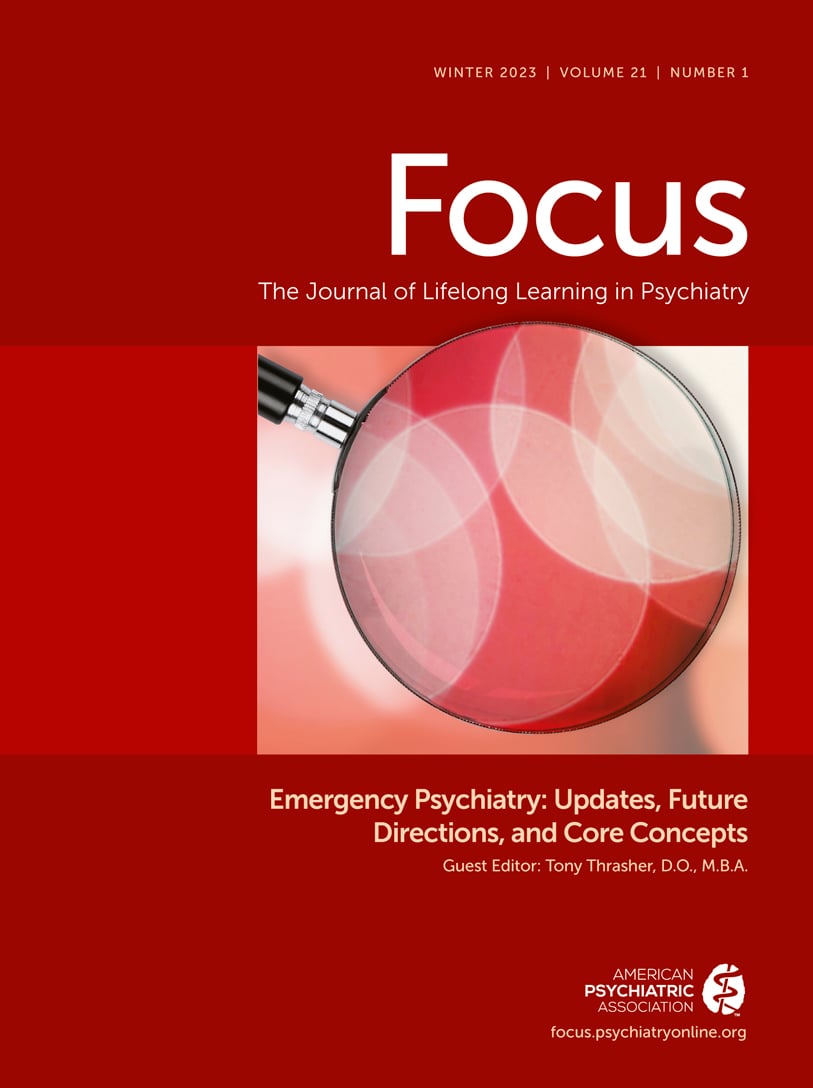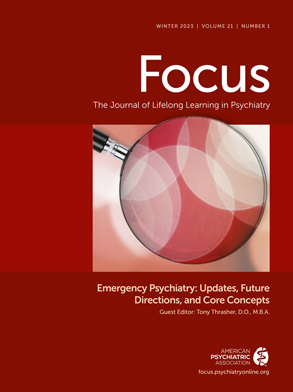Although at times restraint and seclusion remain necessary to protect patients and staff, the risk to both groups must be carefully weighed against the benefit in any given case. Staff and patients alike are at risk of injury during such interventions.
Adverse effects of restraint and seclusion.
Estimates of PTSD in patients who have been restrained vary from 25% to 47%, according to a 2019 systematic review by Chieze et al. (
10). The same review noted that most patients’ emotional reactions to restraint and seclusion were negative, particularly “feelings of punishment and distress,” although there were some reports of positive reactions, such as feelings of “safety, help.” Additionally, Chieze et al. found that those with a history of trauma prior to the restraint had higher rates of PTSD than those without such history. Thus, the potential for confounding variables cannot be ignored; for instance, patients may already have PTSD. Therefore, awareness of possible preexisting PTSD and re-traumatization is important when considering restrictive measures.
In addition to the aforementioned potential adverse effects, recent studies have demonstrated that patients belonging to vulnerable groups, including those with public or no insurance, African American men, and homeless patients, are more likely than their counterparts to be restrained (
11,
12). Such social determinants of health, and the potential role of systemic racism and unconscious bias, are similarly important reasons to carefully consider approaches to minimize use of restrictive measures and to maximize collaborative approaches to preventing aggression.
Several professional organizations have recognized a need to limit the use of restraint and seclusion, including the American Psychiatric Nurses Association (
13) and the American Association for Emergency Psychiatry (
14). The Joint Commission standards (
15), as of 2009, state that restraint and seclusion should be used “only when it can be clinically justified or when warranted by patient behavior that threatens the physical safety of the patient, staff, or others,” and one of the key elements of performance for the standard requires that such measures be used “only when less restrictive interventions are ineffective.”
Strategies for reducing restraint and seclusion.
Some strategies for reducing restraint and seclusion include unit or department culture and education, administrative review and oversight, changes to the physical structure of treatment spaces, early identification of at-risk patients, staff training in de-escalation techniques, drills or simulations involving standardized patients, and debriefing of staff and patients after incidents.
The Safewards model (
16), for example, identifies six domains: patient community, patient characteristics, regulatory framework, staff team, physical environment, and outside hospital. These each can have an impact on conflict (countertherapeutic behaviors, including self-harm, aggression, and elopement) and containment (steps taken to prevent or mitigate conflict). These domains are used to identify individual and group characteristics of staff and patients, as well as regulatory frameworks, physical layout, and factors outside the hospital, that give rise to “flashpoints.” Flashpoints are circumstances that may give rise to conflict (e.g., involuntary commitment, denial of exit from unit, receipt of bad news, conflict with visitors, disagreement among patients). In this model, patient and staff modifiers are proposed that can mitigate the risk of the above factors giving rise to flashpoints and conflict. For example, if the patient is experiencing paranoia and referential thinking, staff modifiers may include providing appropriate medication and/or psychoeducation and helping the patient plan for triggers, such as having too many people around (e.g., the patient may be able to voluntarily use a comfort room or other space when the unit is crowded) (
16).
Several programs aimed at reducing the use of restrictive interventions also have been based on the “Six Core Strategies” outlined by Kevin Huckshorn (
17): leadership toward organizational change; data-informed practice; workforce development (e.g., education, training, appointment to a steering committee); tools to reduce seclusion and/or restraint (e.g., de-escalation techniques and assessments of risk factors for aggression and for death or injury caused by restraint use); consumer roles in inpatient settings (e.g., giving choices where possible and using peer specialists to empower consumers); and debriefing techniques.
Programs based on the Six Core Strategies have shown progress in reducing use of restraint and seclusion across several studies. In fact, a 4-year study (
18) involving Connecticut Valley Hospital, a 650-bed inpatient public sector psychiatric hospital, was found to decrease annual restraint hours by 89% (from 5,300 baseline restraint hours to 570) and annual worker’s compensation medical costs by 24% (from $780,937 baseline compensation to $527,715). A review (
19) of restraint and seclusion programs created on the basis of the Six Core Strategies, and conducted in various countries, also showed promising preliminary results.
Simulated patient scenarios are another way to provide an opportunity to increase staff comfort with their roles on an interdisciplinary response team. A multimodal curriculum (
20) developed to educate emergency medicine residents, nurses, and hospital police officers yielded encouraging results. Staff were recruited to act as standardized patients with agitation in two clinical scenarios. Learners were assigned to multidisciplinary teams and received didactic education in de-escalation techniques, proper application of restraints, and crisis management principles. They also participated in simulations with standardized patients, with each learner assigned a defined role on the response team. Participants’ survey responses indicated improved attitudes toward many factors affecting patient care. The authors also noted that the curriculum generated ideas for multiple quality improvement projects, which were subsequently carried out. Limitations of the project included the significant resources required to train staff and to conduct simulations (
20).
Post seclusion/restraint conferences, also known as post incident reviews or debriefing, are often used in psychiatric settings. These can take many forms, and they may involve patients as well as staff or just staff. Although there have been mixed reviews on the efficacy of such practices, the diverse array of specific post incident review protocols has made finding definitive results difficult. However, a large-scale review of the literature (
21) examining post incident reviews/conferences of varying types indicated that debriefing can significantly decrease subsequent seclusion and restraint. The Goulet and Larue literature review (
21) included studies from several countries, including the United States, Canada, Australia, and the United Kingdom. The authors described post seclusion/restraint review as “highly recommended and vital to improving the care experience for both patients and staff, developing best practices, and reducing the incidence of seclusion/restraint.” However, they also noted a wide range of practices, and suggested a typology stratified by whether an intervention focused on staff, the patient, or both. They suggested further study to identify the weighted impact of the various components.
Another study (
22) focused on interviewing staff from two programs in Norway—one university based and one community based—about their experiences with post incident reviews. In that study (
22), Hammervold et al. interviewed 19 multidisciplinary providers. Overall, those interviewed felt that such reviews had the potential to improve quality of care, but that the potential for improvement would be greater if they were able to more effectively elicit patient perspectives during such reviews. The study authors cited difficulty in engaging with some of the patients, in part because of patient “passivity” during the post incident reviews. The authors suggested the potential for including input from family members, peers, or advocates, in addition to providing training for staff in how to engage patients in the process. Similar skills could also be used to engage the patient prior to an incident, as a means of more effective de-escalation and/or prevention (
22).
The similarities in approaches to post-incident debriefing or review across several countries underscore the global nature of psychiatry’s goals of reducing restrictive interventions and maintaining the safest possible environment for staff and patients. Furthermore, there is significant overlap between strategies for reducing restraint and seclusion and to prevent violence. As we review additional strategies for managing aggression and violence, these alternatives can be thought of as opportunities to intervene earlier in the treatment course.

